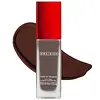Mac Cosmetics Studio Fix Powder Plus Foundation Versus One/Size by Patrick Starrr Turn Up The Base Full Beat Liquid Foundation
What's inside
What's inside
 Key Ingredients
Key Ingredients

 Benefits
Benefits

 Concerns
Concerns

No concerns
 Ingredients Side-by-side
Ingredients Side-by-side

Synthetic Fluorphlogopite
Magnesium Potassium Fluorosilicate
AbrasiveBoron Nitride
AbsorbentAluminum Starch Octenylsuccinate
AbsorbentAluminum Hydroxide
EmollientOctyldodecyl Stearoyl Stearate
EmollientHydrogenated Vegetable Oil
EmollientSilica
AbrasiveDimethicone
EmollientIllite
AbrasiveZinc Stearate
Cosmetic ColorantDicalcium Phosphate
AbrasivePentaerythrityl Tetraisostearate
EmollientSilybum Marianum Seed Oil
Skin ConditioningNannochloropsis Oculata Extract
HumectantAlaria Esculenta Extract
Skin ProtectingPorphyra Umbilicalis Extract
Skin ConditioningRosa Hybrid Flower Extract
Skin ConditioningCaprylic/Capric Triglyceride
MaskingCaprylyl Glycol
EmollientBisabolol
MaskingEthylhexylglycerin
Skin ConditioningKaolin
AbrasiveMica
Cosmetic ColorantTriethoxycaprylylsilane
Sorbitan Tristearate
EmulsifyingPentaerythrityl Tetra-Di-T-Butyl Hydroxyhydrocinnamate
AntioxidantTocopherol
AntioxidantCI 77891
Cosmetic ColorantCI 77491
Cosmetic ColorantCI 77492
Cosmetic ColorantCI 77499
Cosmetic ColorantCI 77163
Cosmetic ColorantCI 77289
Cosmetic ColorantCI 77288
Cosmetic ColorantCI 77510
Cosmetic ColorantCI 77742
Cosmetic ColorantCI 15850
Cosmetic ColorantCI 77007
Cosmetic ColorantCI 42090
Cosmetic ColorantCI 45410
Cosmetic ColorantCI 73360
Cosmetic ColorantCI 19140
Cosmetic ColorantCI 15985
Cosmetic ColorantSynthetic Fluorphlogopite, Magnesium Potassium Fluorosilicate, Boron Nitride, Aluminum Starch Octenylsuccinate, Aluminum Hydroxide, Octyldodecyl Stearoyl Stearate, Hydrogenated Vegetable Oil, Silica, Dimethicone, Illite, Zinc Stearate, Dicalcium Phosphate, Pentaerythrityl Tetraisostearate, Silybum Marianum Seed Oil, Nannochloropsis Oculata Extract, Alaria Esculenta Extract, Porphyra Umbilicalis Extract, Rosa Hybrid Flower Extract, Caprylic/Capric Triglyceride, Caprylyl Glycol, Bisabolol, Ethylhexylglycerin, Kaolin, Mica, Triethoxycaprylylsilane, Sorbitan Tristearate, Pentaerythrityl Tetra-Di-T-Butyl Hydroxyhydrocinnamate, Tocopherol, CI 77891, CI 77491, CI 77492, CI 77499, CI 77163, CI 77289, CI 77288, CI 77510, CI 77742, CI 15850, CI 77007, CI 42090, CI 45410, CI 73360, CI 19140, CI 15985
Water
Skin ConditioningPropanediol
SolventCoco-Caprylate/Caprate
EmollientLauroyl Lysine
Skin ConditioningC13-15 Alkane
SolventTrimethylsiloxysilicate
EmollientPolyglyceryl-3 Polyricinoleate
EmulsifyingC9-12 Alkane
Solvent1,2-Hexanediol
Skin ConditioningDisteardimonium Hectorite
StabilisingSynthetic Fluorphlogopite
Magnesium Sulfate
Aluminum Hydroxide
EmollientHydrogenated Lecithin
EmulsifyingTocopherol
AntioxidantOryza Sativa Hull Powder
AbrasiveCI 77891
Cosmetic ColorantIron Oxides
Water, Propanediol, Coco-Caprylate/Caprate, Lauroyl Lysine, C13-15 Alkane, Trimethylsiloxysilicate, Polyglyceryl-3 Polyricinoleate, C9-12 Alkane, 1,2-Hexanediol, Disteardimonium Hectorite, Synthetic Fluorphlogopite, Magnesium Sulfate, Aluminum Hydroxide, Hydrogenated Lecithin, Tocopherol, Oryza Sativa Hull Powder, CI 77891, Iron Oxides
 Reviews
Reviews

Ingredients Explained
These ingredients are found in both products.
Ingredients higher up in an ingredient list are typically present in a larger amount.
Aluminum Hydroxide is a form of aluminum. It can be naturally found in nature as the mineral gibbsite. In cosmetics, Aluminum Hydroxide is used as a colorant, pH adjuster, and absorbent.
As a colorant, Aluminum Hydroxide may add opacity, or reduce the transparency. Aluminum hydroxide is contains both basic and acidic properties.
According to manufacturers, this ingredient is an emollient and humectant. This means it helps hydrate the skin.
In medicine, this ingredient is used to help relieve heartburn and help heal ulcers.
There is currently no credible scientific evidence linking aluminum hydroxide in cosmetics to increased cancer risk.
Major health organizations allow the use of aluminum hydroxide in personal care products and have not flagged it as a carcinogenic risk at typical usage levels.
Learn more about Aluminum HydroxideCi 77891 is a white pigment from Titanium dioxide. It is naturally found in minerals such as rutile and ilmenite.
It's main function is to add a white color to cosmetics. It can also be mixed with other colors to create different shades.
Ci 77891 is commonly found in sunscreens due to its ability to block UV rays.
Learn more about CI 77891Synthetic Fluorphlogopite is the synthethic version of mica. It consists of fluorine, aluminum and silicate.
Synthetic Fluorphlogopite is used to add volume to products.
It is considered non-irritating on the skin.
Learn more about Synthetic FluorphlogopiteTocopherol (also known as Vitamin E) is a common antioxidant used to help protect the skin from free-radicals and strengthen the skin barrier. It's also fat soluble - this means our skin is great at absorbing it.
Vitamin E also helps keep your natural skin lipids healthy. Your lipid skin barrier naturally consists of lipids, ceramides, and fatty acids. Vitamin E offers extra protection for your skin’s lipid barrier, keeping your skin healthy and nourished.
Another benefit is a bit of UV protection. Vitamin E helps reduce the damage caused by UVB rays. (It should not replace your sunscreen). Combining it with Vitamin C can decrease sunburned cells and hyperpigmentation after UV exposure.
You might have noticed Vitamin E + C often paired together. This is because it is great at stabilizing Vitamin C. Using the two together helps increase the effectiveness of both ingredients.
There are often claims that Vitamin E can reduce/prevent scarring, but these claims haven't been confirmed by scientific research.
Learn more about Tocopherol